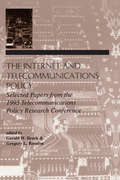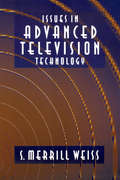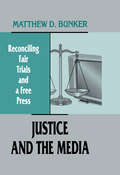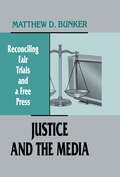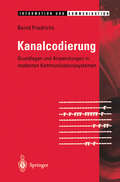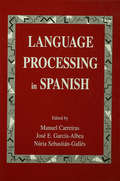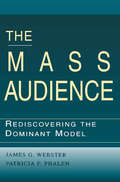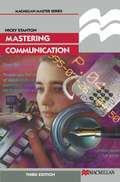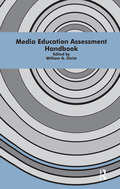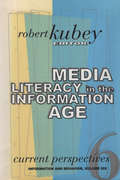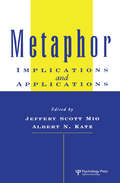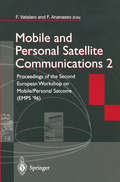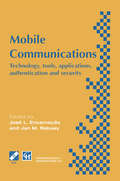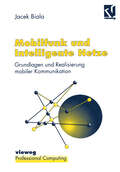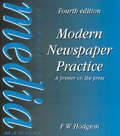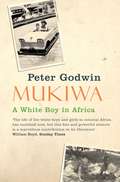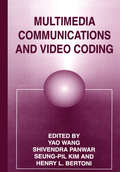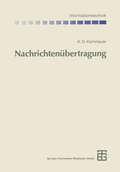- Table View
- List View
The Internet and Telecommunications Policy: Selected Papers From the 1995 Telecommunications Policy Research Conference (Lea Telecommunications Ser.)
by Gerald W. Brock, Gregory L. RosstonThis book is based on the Telecommunications Policy Research Conference which reports on research into telecommunications policy issues. While the conference is now a respectable 23 years old, this is only the second printed edition of selected papers. A new law, the Telecommunications Act of 1996, accelerated the process of integration in the communication industry and made major revisions to the Communications Act of 1934 that increase the incentive for integration within the industry. Although the papers in this volume were written prior to the passage of the new law, their importance is merely enhanced by it. They deal with fundamental, complex policy problems that arise when previously separate segments of the telecommunications industry are integrated, rather than specific regulatory rules that are likely to be changed under the new law. With the passage of this law, the timeframe for developing appropriate policies for an integrated industry has been shortened. Changes expected to occur over a period of several years will now likely occur much more rapidly. These papers provide insights to help guide the transition in the industry. Divided into five parts, this volume: * deals with problems of transforming local exchange telephone service from a monopoly in each geographical area to an interconnected competitive network of networks, * considers the pricing problems that arise in an integrated network carrying traffic of different types across multiple service providers, * examines the problem of achieving interoperability in complex networks, * considers issues of intellectual property that arise in expected integrated networks of the future, and * discusses electronic publication of scholarly journals, copyright protection, and the applicability of copyright law in the digital age.
Issues in Advanced Television Technology
by S. Merrill WeissDrawn from the pages of his popular ¦Advanced Television¦ column in TV Technology magazine, Issues in Advanced Television Technology collects the new television writings of technical author S. Merrill Weiss. Noted for his relaxed, conversational style and easily understood explanations, Weiss leads the reader on an enjoyable trip through the latest developments, making highly complex subjects accessible to those with all levels of experience. His material is of value to business managers making strategic decisions, technical managers forming implementation choices, as well as system designers and operators preparing for future work assignments. Included in the discussion are the interests of broadcasting, cable, wireless cable, telcos, DBS, and packaged media. Covering the broad range of new technologies with a depth not achieved elsewhere short of textbooks, Weiss introduces subjects such as digital video compression, transmission of digital signals, audio compression, adaptive equalizers, packetization, transport and program streams, multiplexing, MPEG-2, serial digital jitter, storage and servers, data broadcasting, and the motivations of the players in the media of the future. Merill's articles are collected by many, but early back issues are no longer available. Now, get all the articles in one place, organized by topic, updated and indexed. Catch up on what you've missed! Take advantage of the easy access. Increase your knowledge. Prepare for your future. Let Issues in Advanced Television Technology take you on an exploration of the marvels of the next generation of video technology.S Merrill Weiss is an award-winning consultant in electronic media technology, technology management, and management. He has nearly three decades of personal experience developing and implementing new television technologies, participating in the writing of standards, and generally thinking about how to move the industry forward. Through his regular monthly series of articles, and now through this, his second book, he shares his understanding of where things are going.
Issues in Advanced Television Technology
by S. Merrill WeissDrawn from the pages of his popular ¦Advanced Television¦ column in TV Technology magazine, Issues in Advanced Television Technology collects the new television writings of technical author S. Merrill Weiss. Noted for his relaxed, conversational style and easily understood explanations, Weiss leads the reader on an enjoyable trip through the latest developments, making highly complex subjects accessible to those with all levels of experience. His material is of value to business managers making strategic decisions, technical managers forming implementation choices, as well as system designers and operators preparing for future work assignments. Included in the discussion are the interests of broadcasting, cable, wireless cable, telcos, DBS, and packaged media. Covering the broad range of new technologies with a depth not achieved elsewhere short of textbooks, Weiss introduces subjects such as digital video compression, transmission of digital signals, audio compression, adaptive equalizers, packetization, transport and program streams, multiplexing, MPEG-2, serial digital jitter, storage and servers, data broadcasting, and the motivations of the players in the media of the future. Merill's articles are collected by many, but early back issues are no longer available. Now, get all the articles in one place, organized by topic, updated and indexed. Catch up on what you've missed! Take advantage of the easy access. Increase your knowledge. Prepare for your future. Let Issues in Advanced Television Technology take you on an exploration of the marvels of the next generation of video technology.S Merrill Weiss is an award-winning consultant in electronic media technology, technology management, and management. He has nearly three decades of personal experience developing and implementing new television technologies, participating in the writing of standards, and generally thinking about how to move the industry forward. Through his regular monthly series of articles, and now through this, his second book, he shares his understanding of where things are going.
Justice and the Media: Reconciling Fair Trials and A Free Press (Routledge Communication Series)
by Matthew D. BunkerUSE THIS FIRST PARAGRAPH ONLY FOR GENERAL CATALOGS... The First Amendment right of free speech is a fragile one. Its fragility is found no less in legal opinions than in other, less specialized forms of public discourse. Both its fragility and its sometimes surprising resiliency are reflected in this book. It provides an examination of how the U.S. Supreme Court has dealt with the problem of restrictions on media coverage of the criminal justice system, as well as how lower courts have interpreted the law created by the Supreme Court. The author explores the degree to which the Court has created a coherent body of law that protects free expression values while permitting reasonable government regulation, and examines the Supreme Court's jurisprudence concerning prior restraints, post-publication sanctions on the press, and their right of access to criminal proceedings. This is a study of the evolution of constitutional doctrine -- particularly when transported from the rarefied air of the Supreme Court to lower court judges who may not share the values of the jurists above them in the judicial hierarchy. The book's greatest strength lies in its thorough analysis and critique of how judges apply First Amendment doctrine to the complex problem of providing for both a "free press" and "fair trials." Much of the available literature on this topic focuses on legal doctrine, but with attention to the legal rules that emerge from the courts, rather than examining and critiquing the judicial techniques that produce those rules. Moreover, although a significant body of scholarship has explored Supreme Court doctrine, this work is one of the few that trace the influence of those doctrines through lower federal court decisions. The hope is to produce a reasonably accurate -- if partial -- picture of how intermediate appellate and trial courts use U.S. Supreme Court doctrine to decide First Amendment cases. Note: This book is necessarily influenced by the 'round-the-clock' press coverage of the recent O.J. Simpson trial. Although the Simpson case did not make new law, the trial and its outcome seem to be -- at this writing -- an inescapable part of how many people think about these issues. The simple truth, however, is that the Simpson case was an anomaly that has little relation to the everyday concerns of media coverage of the criminal justice system. While the venerable "parade of horribles" can be an effective strategy for the legal advocate, it is not always the ideal way to address larger concerns, particularly when fundamental rights are at stake.
Justice and the Media: Reconciling Fair Trials and A Free Press (Routledge Communication Series)
by Matthew D. BunkerUSE THIS FIRST PARAGRAPH ONLY FOR GENERAL CATALOGS... The First Amendment right of free speech is a fragile one. Its fragility is found no less in legal opinions than in other, less specialized forms of public discourse. Both its fragility and its sometimes surprising resiliency are reflected in this book. It provides an examination of how the U.S. Supreme Court has dealt with the problem of restrictions on media coverage of the criminal justice system, as well as how lower courts have interpreted the law created by the Supreme Court. The author explores the degree to which the Court has created a coherent body of law that protects free expression values while permitting reasonable government regulation, and examines the Supreme Court's jurisprudence concerning prior restraints, post-publication sanctions on the press, and their right of access to criminal proceedings. This is a study of the evolution of constitutional doctrine -- particularly when transported from the rarefied air of the Supreme Court to lower court judges who may not share the values of the jurists above them in the judicial hierarchy. The book's greatest strength lies in its thorough analysis and critique of how judges apply First Amendment doctrine to the complex problem of providing for both a "free press" and "fair trials." Much of the available literature on this topic focuses on legal doctrine, but with attention to the legal rules that emerge from the courts, rather than examining and critiquing the judicial techniques that produce those rules. Moreover, although a significant body of scholarship has explored Supreme Court doctrine, this work is one of the few that trace the influence of those doctrines through lower federal court decisions. The hope is to produce a reasonably accurate -- if partial -- picture of how intermediate appellate and trial courts use U.S. Supreme Court doctrine to decide First Amendment cases. Note: This book is necessarily influenced by the 'round-the-clock' press coverage of the recent O.J. Simpson trial. Although the Simpson case did not make new law, the trial and its outcome seem to be -- at this writing -- an inescapable part of how many people think about these issues. The simple truth, however, is that the Simpson case was an anomaly that has little relation to the everyday concerns of media coverage of the criminal justice system. While the venerable "parade of horribles" can be an effective strategy for the legal advocate, it is not always the ideal way to address larger concerns, particularly when fundamental rights are at stake.
Kanalcodierung: Grundlagen und Anwendungen in modernen Kommunikationssystemen (Information und Kommunikation)
by Bernd FriedrichsLanguage Processing in Spanish
by Manuel Carreiras N£ria Sebasti Nbsp N-Gall Jose E. Garcia-Albea Nuria Sebastian-Galles E. Garc¡a-Albea JosThis book presents a set of contributions to the current flow of psycholinguistic research, with new and challenging data gathered from Spanish that may illuminate issues about the generality of language processing models. Although it is possible to find a considerable amount of papers on psycholinguistic research with the Spanish language published in English-speaking journals, unfortunately, the scientific community does not have access to an overview of psycholinguistics in Spain. This book overcomes these limitations because it brings together state-of-the-art descriptions of the research and theory of the different subareas of psycholinguistics currently being studied in Spain. Spanish, the third most widely-used language in the world, differs from English in a number of important respects. Since English has been predominant in psycholinguistic research, contrasting properties of Spanish may help to test the generality of language processing mechanisms and to refine their description. The set of contrasting features considered in this book includes acoustical and syllabic transparency, shallow orthography, a much richer morphology, flexibility in word order, less variability in intonational contours, and the existence of null pronominal subjects for inflected verbs. There are also interesting contrasts in the frequency of different linguistic units, whose impact on language processing is also evaluated. One of the main lines of argument throughout this book deals with the tension between universality and variation as a way of characterizing the functioning of language capacities and processes. The variety of topics covered by this book ranges from one end of the spectrum of language related behavior to the other: speech perception, lexical access in word recognition, relations between phonological and orthographic representations, sentence processing, discourse comprehension, and language production. All chapters focus on questions of general interest within each topic, and in most cases they appeal to one particular feature of the Spanish language that is relevant for a given question. Most chapters show the indisputable importance of crosslinguistic research in psycholinguistics to improve understanding on whether universal cognitive mechanisms and language specific routines underlie the ability of understanding and producing language.
Language Processing in Spanish
by Manuel Carreiras José E. García-Albea Núria Sebastián-GallésThis book presents a set of contributions to the current flow of psycholinguistic research, with new and challenging data gathered from Spanish that may illuminate issues about the generality of language processing models. Although it is possible to find a considerable amount of papers on psycholinguistic research with the Spanish language published in English-speaking journals, unfortunately, the scientific community does not have access to an overview of psycholinguistics in Spain. This book overcomes these limitations because it brings together state-of-the-art descriptions of the research and theory of the different subareas of psycholinguistics currently being studied in Spain. Spanish, the third most widely-used language in the world, differs from English in a number of important respects. Since English has been predominant in psycholinguistic research, contrasting properties of Spanish may help to test the generality of language processing mechanisms and to refine their description. The set of contrasting features considered in this book includes acoustical and syllabic transparency, shallow orthography, a much richer morphology, flexibility in word order, less variability in intonational contours, and the existence of null pronominal subjects for inflected verbs. There are also interesting contrasts in the frequency of different linguistic units, whose impact on language processing is also evaluated. One of the main lines of argument throughout this book deals with the tension between universality and variation as a way of characterizing the functioning of language capacities and processes. The variety of topics covered by this book ranges from one end of the spectrum of language related behavior to the other: speech perception, lexical access in word recognition, relations between phonological and orthographic representations, sentence processing, discourse comprehension, and language production. All chapters focus on questions of general interest within each topic, and in most cases they appeal to one particular feature of the Spanish language that is relevant for a given question. Most chapters show the indisputable importance of crosslinguistic research in psycholinguistics to improve understanding on whether universal cognitive mechanisms and language specific routines underlie the ability of understanding and producing language.
The Mass Audience: Rediscovering the Dominant Model (Routledge Communication Series)
by James Webster Patricia F. PhalenIn the early 20th century, a new and distinctive concept of the audience rose to prominence. The audience was seen as a mass -- a large collection of people mostly unknown to one another -- that was unified through exposure to media. This construct offered a pragmatic way to map audiences that was relevant to industry, government, and social theorists. In a relatively short period of time, it became the dominant model for studying the audience. Today, it is so pervasive that most people simply take it for granted. Recently, media scholars have reopened inquiry into the meaning of "audience." They question the utility of the mass audience concept, characterizing it as insensitive to differences among audience members inescapably bound up with discredited notions of mass society, or serving only a narrow set of industrial interests. The authors of this volume find that these assertions are often false and unwarranted either by the historical record or by contemporary industry practice. Instead, they argue for a rediscovery of the dominant model by summarizing and critiquing the very considerable body of literature on audience behavior, and by demonstrating different ways of analyzing mass audiences. Further, they provide a framework for understanding the future of the audience in the new media environment, and suggest how the concept of mass audience can illuminate research on media effects, cultural studies, and media policy.
The Mass Audience: Rediscovering the Dominant Model (Routledge Communication Series)
by James Webster Patricia F. PhalenIn the early 20th century, a new and distinctive concept of the audience rose to prominence. The audience was seen as a mass -- a large collection of people mostly unknown to one another -- that was unified through exposure to media. This construct offered a pragmatic way to map audiences that was relevant to industry, government, and social theorists. In a relatively short period of time, it became the dominant model for studying the audience. Today, it is so pervasive that most people simply take it for granted. Recently, media scholars have reopened inquiry into the meaning of "audience." They question the utility of the mass audience concept, characterizing it as insensitive to differences among audience members inescapably bound up with discredited notions of mass society, or serving only a narrow set of industrial interests. The authors of this volume find that these assertions are often false and unwarranted either by the historical record or by contemporary industry practice. Instead, they argue for a rediscovery of the dominant model by summarizing and critiquing the very considerable body of literature on audience behavior, and by demonstrating different ways of analyzing mass audiences. Further, they provide a framework for understanding the future of the audience in the new media environment, and suggest how the concept of mass audience can illuminate research on media effects, cultural studies, and media policy.
Mastering Communication (Macmillan Master Series)
by Nicky StantonEffective communication is the key to success! This book is for anyone wishing to improve their communication skills and knowledge of the way in which communications function in organisations. * the third edition of this highly successful book has been fully revised to bring it fully up to date and incorporates latest electronic developments * covers the skills of speaking, writing, listening and effective reading * provides detailed guidance on telephoning, interviewing, meetings, speaking in public, letter and report writing, visual and non-verbal communication and the use of visual aids * contains useful sections on grammar and usage, checklists on spelling and commonly misused and confused words * activities, assignments, self-checks and exercises are included throughout
Media Education Assessment Handbook: A Resource Handbook For Educators And Administrators: Component 3: Developing An Assessment Plan (Routledge Communication Series)
by William G. ChristAssessing media education is a formidable task because both assessment and media education are complex and controversial concepts. Assessment, which can take place at the individual student, class, sequence, program, department or unit, and university levels, is questioned in terms of reliability, validity, relevance, and cost. Media education, which has been challenged at a number of schools, finds faculty and administrators in the midst of soul-searching about how to clearly articulate its missions and purposes to a broader audience. Departments are under increasing national, state, and institutional pressure to get assessment procedures carried out quickly, but there is an obvious danger in rushing to implement assessment strategies before establishing what is essential in media education. In communication education in general, the "what" of assessment is often discussed in terms of skills, attitudes, affect, values, and knowledge. People assess students to determine what they know, think, feel, value, and can do. Here it is suggested that one of the places to start defining what students should learn from their media education is by identifying outcomes. Outcomes can be assessed in a variety of ways, but first they need to be developed and clearly articulated.
Media Education Assessment Handbook (Routledge Communication Series)
by William G. ChristAssessing media education is a formidable task because both assessment and media education are complex and controversial concepts. Assessment, which can take place at the individual student, class, sequence, program, department or unit, and university levels, is questioned in terms of reliability, validity, relevance, and cost. Media education, which has been challenged at a number of schools, finds faculty and administrators in the midst of soul-searching about how to clearly articulate its missions and purposes to a broader audience. Departments are under increasing national, state, and institutional pressure to get assessment procedures carried out quickly, but there is an obvious danger in rushing to implement assessment strategies before establishing what is essential in media education. In communication education in general, the "what" of assessment is often discussed in terms of skills, attitudes, affect, values, and knowledge. People assess students to determine what they know, think, feel, value, and can do. Here it is suggested that one of the places to start defining what students should learn from their media education is by identifying outcomes. Outcomes can be assessed in a variety of ways, but first they need to be developed and clearly articulated.
Media Literacy Around the World (Information and Behavior Series)
by Robert KubeyAt the dawn of the twenty-first century, education about and through the media has become a worldwide phenomenon, and is playing an increasingly important role in educational reform. The theory and practice of media education have profited greatly from recent and intensive development and application of new information and telecommunications technologies. Consequently, the importance of media and information literacy is taking on an even greater urgency. With this in mind, the contributors to this volume survey what has taken place over the last decade in different parts of the world, examine the current state of theoretical, conceptual, and research development, and consider where media education is going and where it ought to go. With two-thirds of its 22 contributions coming from outside the United States, Media Literacy around the World is a genuine international effort, with many leading media and information educators in the world taking part. The work converts the notion of globalism from a slogan into a working hypothesis. The concerns in this volume are with literacy not just in computer technology, but as a broad concern of the educational process.
Media Literacy Around the World (Information and Behavior Series)
by Robert KubeyAt the dawn of the twenty-first century, education about and through the media has become a worldwide phenomenon, and is playing an increasingly important role in educational reform. The theory and practice of media education have profited greatly from recent and intensive development and application of new information and telecommunications technologies. Consequently, the importance of media and information literacy is taking on an even greater urgency. With this in mind, the contributors to this volume survey what has taken place over the last decade in different parts of the world, examine the current state of theoretical, conceptual, and research development, and consider where media education is going and where it ought to go. With two-thirds of its 22 contributions coming from outside the United States, Media Literacy around the World is a genuine international effort, with many leading media and information educators in the world taking part. The work converts the notion of globalism from a slogan into a working hypothesis. The concerns in this volume are with literacy not just in computer technology, but as a broad concern of the educational process.
Metaphor: Implications and Applications
by Jeffery S. Mio Albert N. KatzResearch on metaphor has been dominated by Aristotelian questions of processes in metaphor understanding. Although this area is important, it leaves unasked Platonic questions of how structures of the mind affect such processes. Moreover, there has been relatively little work on how metaphors affect human behavior. Although there are numerous postdictive or speculative accounts of the power of metaphors to affect human behavior in particular areas, such as clinical or political arenas, empirical verification of these accounts has been sparse. To fill this void, the editors have compiled this work dedicated to empirical examination of how metaphors affect human behavior and understanding. The book is divided into four sections: metaphor and pragmatics, clinical uses of metaphor, metaphor and politics, and other applications of metaphor. Chapters contained within these sections attempt to merge Aristotelian questions with Platonic ones.
Metaphor: Implications and Applications
by Jeffery Scott Mio Albert N. KatzResearch on metaphor has been dominated by Aristotelian questions of processes in metaphor understanding. Although this area is important, it leaves unasked Platonic questions of how structures of the mind affect such processes. Moreover, there has been relatively little work on how metaphors affect human behavior. Although there are numerous postdictive or speculative accounts of the power of metaphors to affect human behavior in particular areas, such as clinical or political arenas, empirical verification of these accounts has been sparse. To fill this void, the editors have compiled this work dedicated to empirical examination of how metaphors affect human behavior and understanding. The book is divided into four sections: metaphor and pragmatics, clinical uses of metaphor, metaphor and politics, and other applications of metaphor. Chapters contained within these sections attempt to merge Aristotelian questions with Platonic ones.
Mobile and Personal Satellite Communications 2: Proceedings of the Second European Workshop on Mobile/Personal Satcoms (EMPS ’96)
by Francesco Vatalaro Fulvio AnanassoThis book of proceedings contains papers for the Second European Workshop on Mobile/Personal Satcoms (EMPS '96), held in Rome, Italy, and hosted by the Consiglio Nazionale delle Ricerche. The EMPS '96 workshop follows the edition of two years ago, and is intended as an occasion for exchange of information and opinions among experts in the fast-growing field of mobile satellite communications. With respect to the first successful edition we only made one main modification. We issued a formal call for papers, instead oflimiting the selection process to invited papers as was in the past: 60 papers were received from 18 countries. Each paper has been reviewed by at least two referees, and then 41 papers were selected by the Workshop Steering Committee (WSC). An invited introductory lecture opens the workshop and is given by Dr. Andrew J. Viterbi, who is also honorary chairman of EMPS '96. Satellite Personal Communications Networks (SPCNs) are now expected to grow very fast, even beyond the most optimistic forecast: their unique feature to establish ex abrupto a world-wide communication fabric is certainly the winning card. Market analyses now indicate that LEO networks already planned to be operational around 1998 even risk being overwhelmed by users request, so that their extensions are already being considered. And, additionally, multimedia SPCNs are also being introduced at higher frequencies to provide broadband services.
Mobile Communications: Technology, tools, applications, authentication and security IFIP World Conference on Mobile Communications 2 – 6 September 1996, Canberra, Australia (IFIP Advances in Information and Communication Technology)
by J. L. Encarnaçao Jan M. RabaeyMobile computing is one of the biggest issues of computer technology, science and industry today. This book looks at the requirements of developing mobile computing systems and the challenges they pose to computer designers. It examines the requirements of mobile computing hardware, infrastructure and communications services. Information security and the data protection aspects of design are considered, together with telecommunications facilities for linking up to the worldwide computer infrastructure. The book also considers the mobility of computer users versus the portability of the equipment. The text also examines current applications of mobile computing in the public sector and future innovative applications.
Mobilfunk und Intelligente Netze: Grundlagen und Realisierung mobiler Kommunikation
by Jacek BialaDas digitale Mobilfunknetz ist eine technische Glanzleistung und zugleich eine der ersten europäischen Anwendungen intelligenter Netze. Diese Technologie hat sehr große Innovationskraft und ist richtungsweisend für weitere Entwicklungen bis über das Jahr 2000 hinaus. Zum Zeitpunkt des Erscheinens des Werkes von Jacek Biala sind die Entwicklungsarbeiten der ersten Phase des paneuropäischen Mobilfunksystems abgeschlossen. Die ihnen zugrundeliegenden Unterlagen (GSM- und CCITT-Empfehlungen) und eine Reihe weiterer, wichtiger Aspekte werden dem Leser durch dieses Buch zugänglich gemacht. Es ist eines der ersten Bücher über digitale, mobile Telekommunikation und intelligente Netze im deutschsprachigen Raum.
Modern Newspaper Practice: A primer on the press (Media Manuals Ser.)
by F W HodgsonAn introduction to all aspects of newspaper journalism and the journalist's world. The book examines in detail not only day-to-day practice but also the role of the editor and the reading public, and the running and printing of newspapers. Close attention in this new edition is paid to the effect of technological advance on news gathering, news and feature writing, page planning and design and the production, advertising and commercial side of newspapers. This book is widely used on journalism and media-related courses, including degrees and those run by newspaper companies and the NCTJ, and the many training schemes abroad that look at British practice.
Modern Newspaper Practice: A primer on the press
by F W HodgsonAn introduction to all aspects of newspaper journalism and the journalist's world. The book examines in detail not only day-to-day practice but also the role of the editor and the reading public, and the running and printing of newspapers. Close attention in this new edition is paid to the effect of technological advance on news gathering, news and feature writing, page planning and design and the production, advertising and commercial side of newspapers. This book is widely used on journalism and media-related courses, including degrees and those run by newspaper companies and the NCTJ, and the many training schemes abroad that look at British practice.
Mukiwa: A White Boy in Africa
by Peter GodwinGrowing up in Rhodesia in the 1960s, Peter Godwin inhabited a magical and frightening world of leopard-hunting, lepers, witch doctors, snakes and forest fires. As an adolescent, a conscript caught in the middle of a vicious civil war, and then as an adult who returned to Zimbabwe as a journalist to cover the bloody transition to majority rule, he discovered a land stalked by death and danger.
Multimedia Communications and Video Coding
by Henry Bertoni S. P. Kim Shivendra Panwar Y. WangThis book constitutes the proceedings of the International Symposium on Multimedia Communications and Video Coding (ISMCVC95) held October 11 - 13, 1995, at the Poly technic University in Brooklyn, New York. This Symposium was organized under the aus pices of the New York State funded Center for Advanced Technology in Telecommunications (CATT), in cooperation with the Communications Society and the Signal Processing Society of the Institute of Electrical and Electronic Engineers (IEEE). In preparing this book, we have summarized the topics presented in various sessions of the Symposium, including the keynote addresses, the Service Provider and Vendor Session, the Panel Discussion, as well as the twelve Technical Sessions. This summary is presented in the Introduction. 'Full papers submitted by the presenters are organized into eleven chapters, divided into three parts. Part I focuses on systems issues in multimedia communications. Part II concentrates on video coding algorithms. Part III discusses the interplay between video coding and network control for video delivery over various channels.
Nachrichtenübertragung (Informationstechnik)
by Karl-Dirk KammeyerDas Buch gliedert sich in vier Teile. Im Teil 1 werden Komplexe Signale und Systeme sowie die Eigenschaften von Übertragungskanälen und Mobilfunkkanälen besprochen. Im Teil 2 geht es um Analoge Basisbandübertragung und Diskretisierung analoger Quellensignale, im Teil 3 um analoge, im Teil 4 um digitale Modulationsformen.
